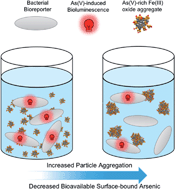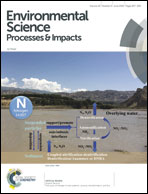Bacterial bioreporter detection of arsenic associated with iron oxides†
Abstract
Bacterial bioreporters are engineered microorganisms that have found recent application as a low-cost method of detecting arsenic (As) in environmental systems. However, no assessment exists of bioreporter detection of particle-bound As. We applied an Escherichia coli-based bioreporter to assess the bioavailability of As(V) adsorbed by goethite (α-FeOOH), 2-line ferrihydrite and As(V) co-precipitated with Fe(III). We found that As(V) bound to the surface of crystalline goethite was not detected by the bioreporters, which contrasted sharply the 50% detection of As(V) adsorbed by ferrihydrite. In addition, the presence of Ca2+ caused a systematic decrease in the bioreporter-detected As(V) fraction in the ferrihydrite samples. For co-precipitated As(V)–Fe(III) samples, we found a similar bioreporter-detected As(V) fraction (<0.2) regardless of crystallite size (0.7–2.5 nm) or As Fe−1 surface loading (10–60 mol%). Our results reveal that the bioreporter response depends largely on aggregated particle size, which is expected to physically isolate As(V) from bioreporters by encapsulating surface-bound As(V) in coagulated flocs. Our results show that while bioreporters do not perform optimally in water that contains Fe particles, this method could be developed for sludge testing and for monitoring As levels in the product water of decentralized Fe-based As treatment systems.

- This article is part of the themed collection: Best Papers 2018 – Environmental Science: Processes & Impacts


 Please wait while we load your content...
Please wait while we load your content...